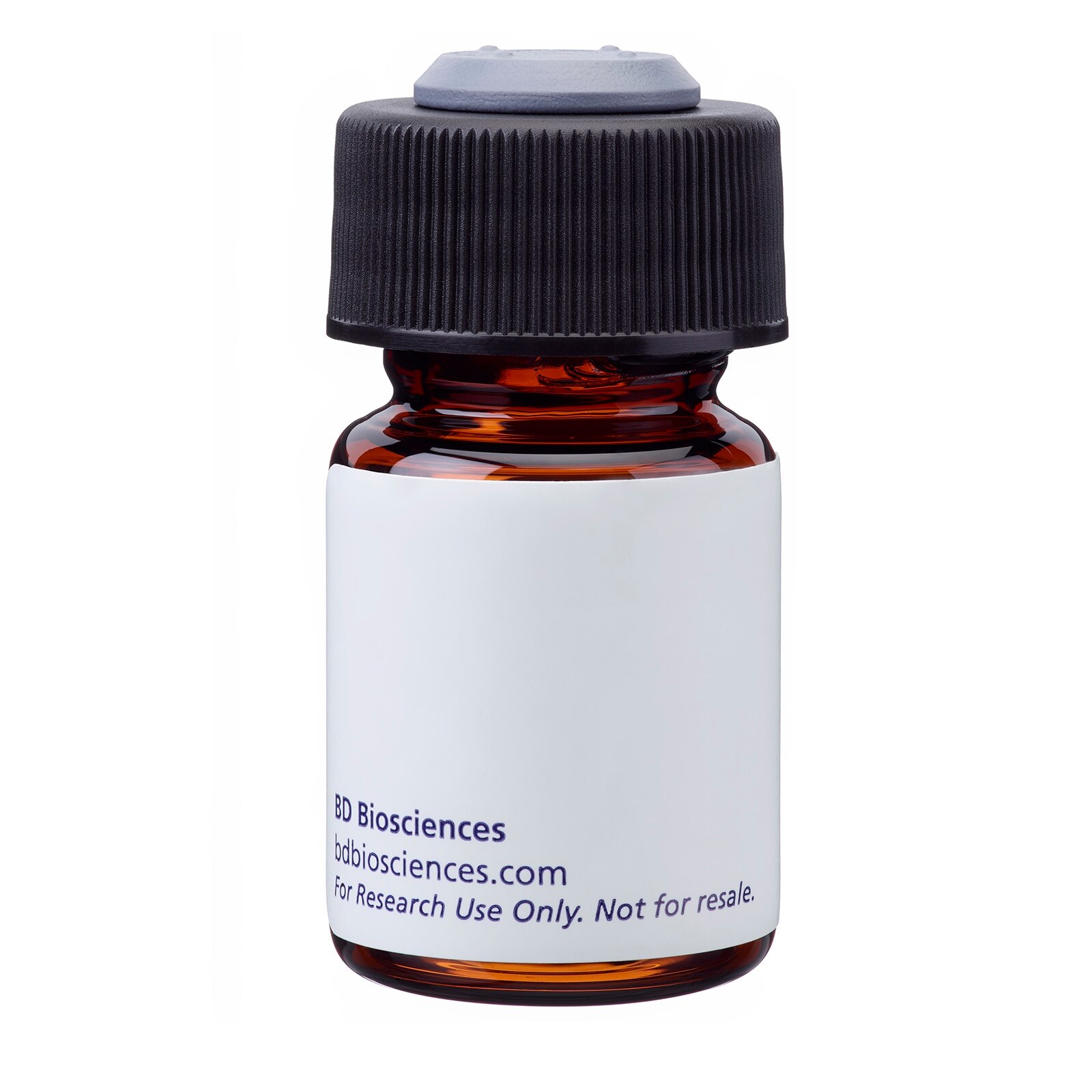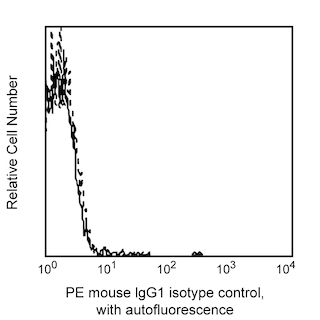-
Your selected country is
Middle East / Africa
- Change country/language
Old Browser
This page has been recently translated and is available in French now.
Looks like you're visiting us from {countryName}.
Would you like to stay on the current country site or be switched to your country?




Flow cytometric analysis of Hut-78 cell line. Hut-78 cells were stained with PE Mouse Anti-Human CD137 Ligand (Cat 559446, solid line histogram) or PE Mouse IgG1, κ Isotype Control (Cat. No. 555749, dashed line histogram). The fluorescence histograms were derived from gated events with the forward and side light-scattering characteristics of viable Hut 78 cells.


BD Pharmingen™ PE Mouse Anti-Human CD137 Ligand

Regulatory Status Legend
Any use of products other than the permitted use without the express written authorization of Becton, Dickinson and Company is strictly prohibited.
Preparation And Storage
Product Notices
- This reagent has been pre-diluted for use at the recommended Volume per Test. We typically use 1 × 10^6 cells in a 100-µl experimental sample (a test).
- An isotype control should be used at the same concentration as the antibody of interest.
- Caution: Sodium azide yields highly toxic hydrazoic acid under acidic conditions. Dilute azide compounds in running water before discarding to avoid accumulation of potentially explosive deposits in plumbing.
- Source of all serum proteins is from USDA inspected abattoirs located in the United States.
- For fluorochrome spectra and suitable instrument settings, please refer to our Multicolor Flow Cytometry web page at www.bdbiosciences.com/colors.
- Please refer to http://regdocs.bd.com to access safety data sheets (SDS).
- Please refer to www.bdbiosciences.com/us/s/resources for technical protocols.
Companion Products



The C65-485 monoclonal antibody specifically recognizes the type II membrane protein known as 4-1BB Ligand (4-1BB-L) or CD137 Ligand (CD137L). This molecule belongs to the TNF superfamily and is encoded by TNFSF9 (Tumor necrosis factor superfamily member 9). CD137 Ligand has been reported to have costimulatory function on activated T cells. Reports suggest that stimulation of activated T cells via CD137 Ligand does not require the presence of other costimulatory molecules, including CD28. Some studies have reported human CD137 Ligand to be expressed preferentially on primary B cells and B-cell lines. The C65-485 antibody is able to react with recombinant human 4-1BB Ligand (rh4-1BB-L/CD137L) bound to CD137 (4-1BB receptor) expressed on phytohemagglutinin (PHA)-stimulated PBMC.

Development References (7)
-
Chu NR, DeBenedette MA, Stiernholm BJ, Barber BH, Watts TH. Role of IL-12 and 4-1BB ligand in cytokine production by CD28+ and CD28- T cells. J Immunol. 1997; 158(7):3081-3089. (Biology). View Reference
-
Cole SL, Benam KH, McMichael AJ, Ho LP. Involvement of the 4-1BB/4-1BBL pathway in control of monocyte numbers by invariant NKT cells.. J Immunol. 2014; 192(8):3898-907. (Clone-specific: Functional assay). View Reference
-
DeBenedette MA, Shahinian A, Mak TW, Watts TH. Costimulation of CD28- T lymphocytes by 4-1BB ligand. J Immunol. 1997; 158(2):551-559. (Biology). View Reference
-
Ju S, Ju S, Ge Y, et al. A novel approach to induce human DCs from monocytes by triggering 4-1BBL reverse signaling.. Int Immunol. 2009; 21(10):1135-44. (Clone-specific: Flow cytometry). View Reference
-
Melero I, Bach N, Hellström KE, Aruffo A, Mittler RS, Chen L. Amplification of tumor immunity by gene transfer of the co-stimulatory 4-1BB ligand: synergy with the CD28 co-stimulatory pathway. Eur J Immunol. 1998; 28(3):1116-1121. (Biology). View Reference
-
Pichler K, Kattan T, Gentzsch J, et al. Strong induction of 4-1BB, a growth and survival promoting costimulatory receptor, in HTLV-1-infected cultured and patients' T cells by the viral Tax oncoprotein.. Blood. 2008; 111(9):4741-51. (Clone-specific: Flow cytometry). View Reference
-
Zhou Z, Kim S, Hurtado J, et al. Characterization of human homologue of 4-1BB and its ligand. Immunol Lett. 1995; 45(1-2):67-73. (Biology). View Reference
Please refer to Support Documents for Quality Certificates
Global - Refer to manufacturer's instructions for use and related User Manuals and Technical data sheets before using this products as described
Comparisons, where applicable, are made against older BD Technology, manual methods or are general performance claims. Comparisons are not made against non-BD technologies, unless otherwise noted.
For Research Use Only. Not for use in diagnostic or therapeutic procedures.
Report a Site Issue
This form is intended to help us improve our website experience. For other support, please visit our Contact Us page.